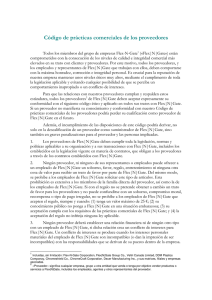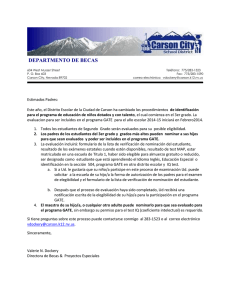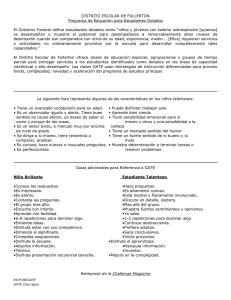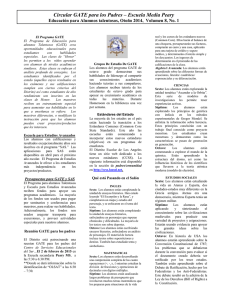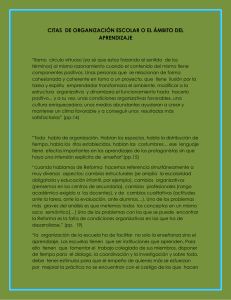A B C D INSTALLATION INSTRUCTIONS
Anuncio
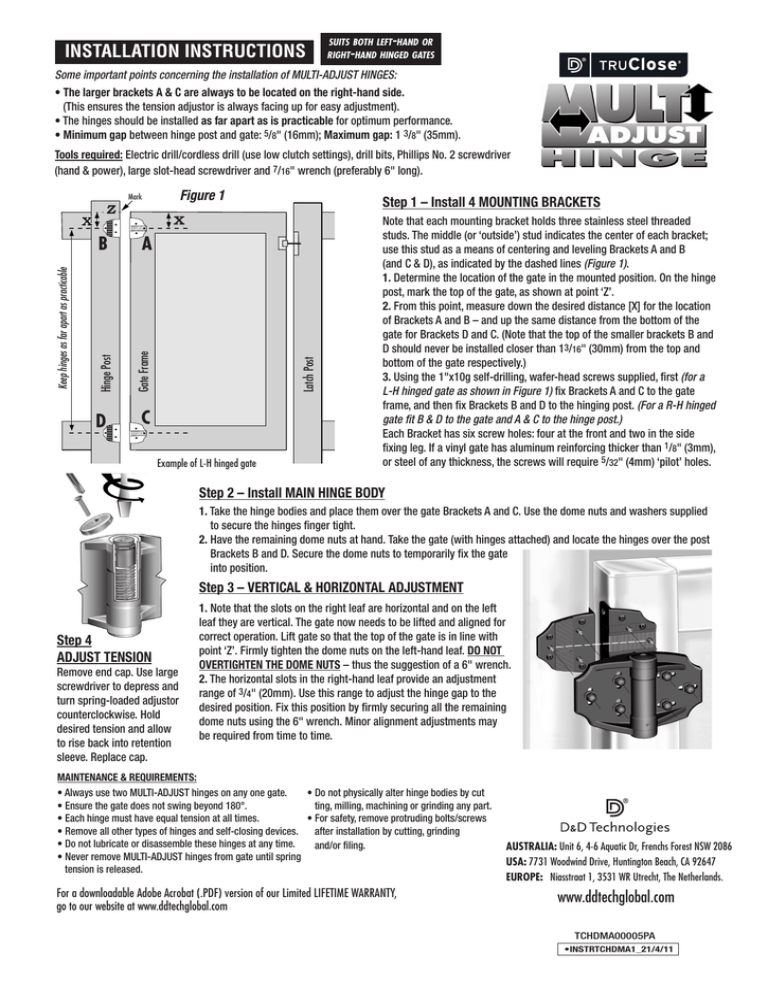
INSTALLATION INSTRUCTIONS suits both left-hand or right-hand hinged gates Some important points concerning the installation of MULTI-ADJUST HINGES: • The larger brackets A & C are always to be located on the right-hand side. (This ensures the tension adjustor is always facing up for easy adjustment). • The hinges should be installed as far apart as is practicable for optimum performance. • Minimum gap between hinge post and gate: 5/8" (16mm); Maximum gap: 1 3/8" (35mm). Tools required: Electric drill/cordless drill (use low clutch settings), drill bits, Phillips No. 2 screwdriver (hand & power), large slot-head screwdriver and 7/16" wrench (preferably 6" long). Figure 1 A Gate Frame D Step 1 – Install 4 MOUNTING BRACKETS Latch Post B Hinge Post Keep hinges as far apart as practicable Mark C Example of L-H hinged gate Note that each mounting bracket holds three stainless steel threaded studs. The middle (or ‘outside’) stud indicates the center of each bracket; use this stud as a means of centering and leveling Brackets A and B (and C & D), as indicated by the dashed lines (Figure 1). 1. Determine the location of the gate in the mounted position. On the hinge post, mark the top of the gate, as shown at point ‘Z’. 2. From this point, measure down the desired distance [X] for the location of Brackets A and B – and up the same distance from the bottom of the gate for Brackets D and C. (Note that the top of the smaller brackets B and D should never be installed closer than 13/16" (30mm) from the top and bottom of the gate respectively.) 3. Using the 1"x10g self-drilling, wafer-head screws supplied, first (for a L-H hinged gate as shown in Figure 1) fix Brackets A and C to the gate frame, and then fix Brackets B and D to the hinging post. (For a R-H hinged gate fit B & D to the gate and A & C to the hinge post.) Each Bracket has six screw holes: four at the front and two in the side fixing leg. If a vinyl gate has aluminum reinforcing thicker than 1/8" (3mm), or steel of any thickness, the screws will require 5/32" (4mm) ‘pilot’ holes. Step 2 – Install MAIN HINGE BODY 1. Take the hinge bodies and place them over the gate Brackets A and C. Use the dome nuts and washers supplied to secure the hinges finger tight. 2. Have the remaining dome nuts at hand. Take the gate (with hinges attached) and locate the hinges over the post Brackets B and D. Secure the dome nuts to temporarily fix the gate into position. Step 3 – VERTICAL & HORIZONTAL ADJUSTMENT Step 4 ADJUST TENSION Remove end cap. Use large screwdriver to depress and turn spring-loaded adjustor counterclockwise. Hold desired tension and allow to rise back into retention sleeve. Replace cap. 1. Note that the slots on the right leaf are horizontal and on the left leaf they are vertical. The gate now needs to be lifted and aligned for correct operation. Lift gate so that the top of the gate is in line with point ‘Z’. Firmly tighten the dome nuts on the left-hand leaf. DO NOT OVERTIGHTEN THE DOME NUTS – thus the suggestion of a 6" wrench. 2. The horizontal slots in the right-hand leaf provide an adjustment range of 3/4" (20mm). Use this range to adjust the hinge gap to the desired position. Fix this position by firmly securing all the remaining dome nuts using the 6" wrench. Minor alignment adjustments may be required from time to time. MAINTENANCE & REQUIREMENTS: • Do not physically alter hinge bodies by cut • Always use two MULTI-ADJUST hinges on any one gate. ting, milling, machining or grinding any part. • Ensure the gate does not swing beyond 180°. • For safety, remove protruding bolts/screws • Each hinge must have equal tension at all times. • Remove all other types of hinges and self-closing devices. after installation by cutting, grinding • Do not lubricate or disassemble these hinges at any time. and/or filing. • Never remove MULTI-ADJUST hinges from gate until spring tension is released. For a downloadable Adobe Acrobat (.PDF) version of our Limited LIFETIME WARRANTY, go to our website at www.ddtechglobal.com AUSTRALIA: Unit 6, 4-6 Aquatic Dr, Frenchs Forest NSW 2086 MADE IN AUSTRALIA USA: 7731 Woodwind Drive, Huntington Beach, CA 92647 EUROPE: Niasstraat 1, 3531 WR Utrecht, The Netherlands. www.ddtechglobal.com TCHDMA00005PA •INSTRTCHDMA1_21/4/11 INSTRUCCIONES PARA LA INSTALACIÓN PARA PUERTAS CON BISAGRAS DE MANO DERECHA E IZQUIERDA Algunos puntos importantes sobre la instalación de BISAGRAS DE AJUSTE MÚLTIPLE (MULTI-ADJUST HINGES, en inglés): • Los soportes más grandes A y C siempre deben colocarse sobre la mano derecha. (esto garantiza que el ajustador de tensión siempre se encuentre hacia arriba facilitando de este modo el ajuste). • Las bisagras deberán instalarse con la máxima separación posible para lograr un funcionamiento óptimo. • La separación mínima entre la bisagra del poste y la puerta debe ser de 5/8" (16mm); la separación máxima debe ser de 1 3/8" (35mm). Herramientas necesarias: Taladro eléctrico/inalámbrico (usar los ajustes de transmisión bajos), mechas para taladro, destornillador Phillips número 2 (manual y eléctrico), destornillador de cabeza con ranura grande y llave de 7/16" (preferentemente de 6" de largo). Marcar Ilustración 1 A Marco de la puerta D C Poste del cerrojo B Poste de bisagra Mantener las bisagras con la máxima separación posible Primer paso – Instalar 4 SOPORTES PARA MONTAR Observación: cada soporte para montar tiene tres pernos de acero inoxidable. El perno del medio (o de “afuera”) indica el centro de cada soporte; usar este perno para centrar y nivelar los soportes A y B (y C y D) de acuerdo con las indicaciones de las líneas entrecortadas (Ilustración 1). 1. Determinar la ubicación de la puerta en la posición montada. En el poste de la bisagra marcar la parte superior de la puerta, como se indica en el punto ‘Z’. 2. Desde este punto medir hacia abajo la distancia deseada [X] para la ubicación de los soportes A y B – y hacia arriba la misma distancia desde la parte inferior de la puerta para los soportes D y C (observación: la parte superior de los soportes más pequeños B y D nunca deberá instalarse más cerca que 13/16" (30mm) desde la parte superior e inferior de la puerta, respectivamente). 3. Usando los tornillos de cabeza flangeada autoroscantes de 1"x10g suministrados, primero (para una puerta de mano I como está ilustrado) fijar los soportes A y C al marco de la puerta y luego los soportes B y D al poste con bisagras (para una puerta sujetada de mano D encajar B y D a la puerta y A y C al poste de soporte.) Cada soporte tiene seis agujeros de tornillo: cuatro en el frente y dos en la pata lateral de fijación. Si una puerta vinílica tiene un refuerzo de aluminio con un grosor mayor de 1/8" (3mm), O acero de cualquier grosor, los tornillos requerirán agujeros “piloto” de 5/32" (4mm). Ejemplo de puerta con bisagra de mano I Segundo paso– Instalar LA CAJA DE BISAGRAS PRINCIPAL 1. Tomar las cajas de las bisagras y colocarlas sobre los soportes de la puerta A y C. Usar las tuercas cúpula y arandelas suministradas para asegurar las bisagras con los dedos. 2. Tener a mano el resto de las tuercas cúpula. Tomar la puerta (con las bisagras adjuntas) y colocar las bisagras por encima de los soportes B y D. Ajustar las tuercas cúpula para fijar en forma provisoria la puerta en posición. Tercer paso – AJUSTE VERTICAL Y HORIZONTAL Cuarto paso AJUSTAR LA TENSIÓN Retirar el tapón. Usar el destornillador grande para soltar y girar el ajustador con resorte en dirección contraria a las agujas del reloj. Sostener en la tensión deseada y dejar que vuelva a la manga de retención. Reemplazar el tapón. 1. Observación: las ranuras de la hoja derecha son horizontales y las de la hoja izquierda son verticales. Ahora la puerta necesita ser levantada y alineada para que funcione correctamente. Levantar la puerta de manera que la parte superior de la misma se encuentre alineada con el punto ‘Z’. Ajustar firmemente las tuercas cúpula en la hoja de la izquierda. NO SOBREAJUSTAR LAS TUERCAS CÚPULA – por lo tanto, la sugerencia es usar una llave de 6". 2. Las ranuras horizontales en la hoja derecha ofrecen una escala de ajuste de 3/4" (20mm). Usar esta escala para ajustar la separación de bisagras en la posición deseada. Fijar esta posición ajustando firmemente el resto de los pernos cúpula usando la llave de 6". Ocasionalmente podrían requerirse ajustes mínimos. MANTENIMIENTO Y REQUISITOS: • Usar siempre dos bisagras de AJUSTE MÚLTIPLE para cualquier puerta. • Asegurarse de que la puerta no se balancee pasando los 180°. • Cada bisagra debe tener la misma tensión en todo momento. • Retirar cualquier otro tipo de bisagra y aparatos de autocierre. • No lubricar ni desarmar estas bisagras en ningún momento. • No retirar nunca las bisagras de AJUSTE MÚLTIPLE de la puerta hasta que se suelte la tensión del resorte. • No cambiar físicamente las cajas de bisagras cortando, fresando, usando maquinaria o esmerilando ninguna de las partes. • Por razones de seguridad, retirar los tornillos/tuercas que sobresalen después de la instalación cortando, fresando y/o esmerilando. Para un version de nuestra garantia limitada de por vida descargable en Adobe Acrobat (.pdf), vaya a nuestro sitio Web en www.ddtechglobal.com AUSTRALIA: Unit 6, 4-6 Aquatic Dr, Frenchs Forest NSW 2086 USA: 7731 Woodwind Drive, Huntington Beach, CA 92647 EUROPE: Niasstraat 1, 3531 WR Utrecht, The Netherlands. www.ddtechglobal.com FABRICADO EN AUSTRALIA TCHDMA00005PA •INSTRTCHDMA1_21/4/11
